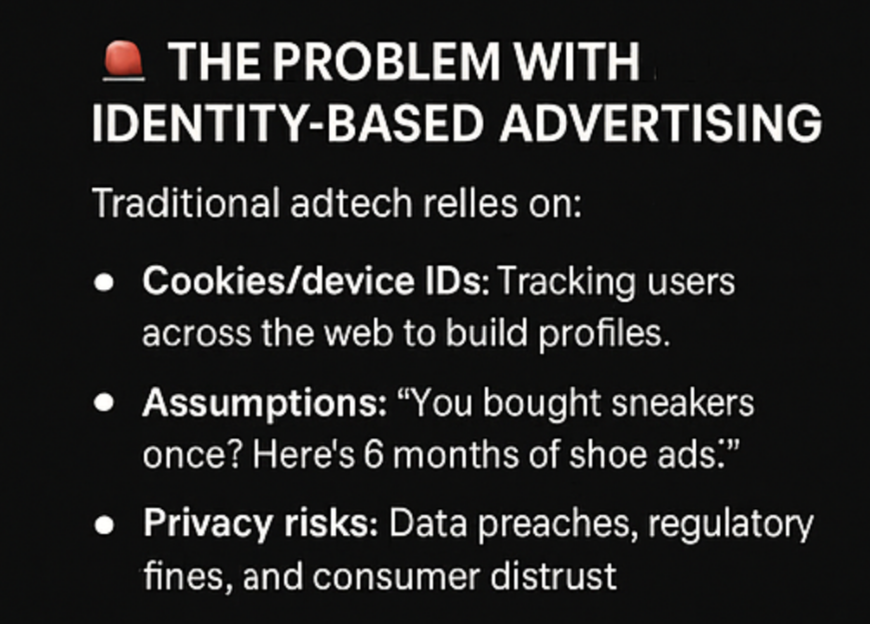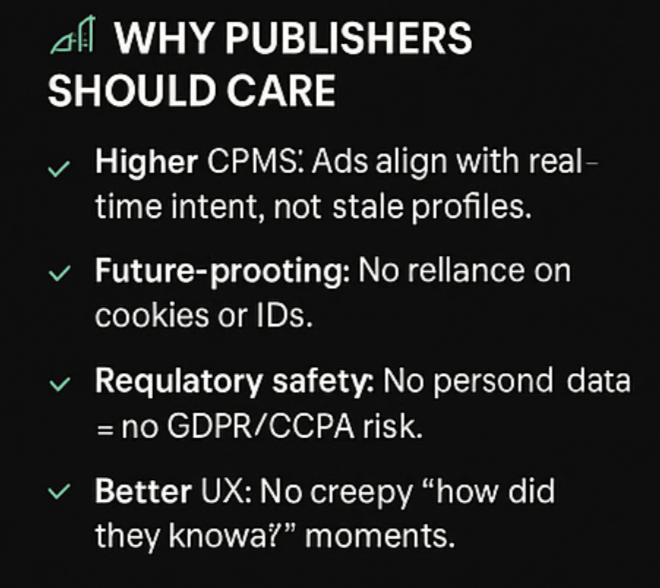For decades, programmatic advertising has been built on a flawed premise: tracking people, rather than their motivations. Cookies, device IDs, and invasive profiling tools promised precision but delivered privacy scandals, wasted spend, and increasingly obsolete tactics.
The alternative? Intent-based advertising, where AI deciphers why a user engages with content, without stalking their personal data.
Let’s break down why publishers need to ditch identity-based models (before they’re left behind).
Why Identity-Based Advertising is Failing

The old model relies on three flawed pillars:
- Cookies & Device IDs – Tracking users across the web to build profiles.
- Historical Data – “You browsed sneakers in March? Here’s more shoe ads in August.”
- Assumptions Over Intent – Labels like “fitness enthusiast” or “pet owner” miss real-time motivation.
The problems?
- Cookies are dying – Blocked by Safari, Firefox, and now Chrome.
- Data decay – 40% of audience segments are inaccurate or outdated.
- Consumer backlash – 81% of users limit tracking due to privacy concerns.
Identity-based ads are like using a Swiss knife to crack a walnut: clumsy, wasteful, and prone to collateral damage.
🔍 The Rise of Intent-Based Advertising
Instead of tracking who someone is, intent-based models analyze:
- Page context – What is this article about?
- Real-time behavior – How is the user engaging?
- Broader signals – Time of day, device, scroll depth, etc.
For example: Selling Tylenol without stalking users.
A traditional ad platform might target:
- “Insomniacs” (based on past search history)
- “Frequent travelers” (from loyalty program data).
An intent-based system sees:
- A user reading an article about dealing with noisy pets at night → infers sleep disruption.
- Someone browsing at 3 AM in Norway → infers trouble sleeping at midnight.
No personal data needed, just context.
How Intent-Based Ads Work

Intent-Based Advertising operates on three levels:
- Reactive – “User searched for ‘best running shoes’ → show Nike shoe ads.” (Basic but limited.)
- Predictive – “User bought running shoes → assume they’ll want protein powder.” (Often wrong.)
- Contextual + Behavioral – “User is reading a marathon training guide → serve hydration gear ads during the session.” (Precise, privacy-safe.)
This isn’t just “smarter targeting”, it’s replacing surveillance with relevance.
How Intent-Based Advertising Works in Apps
Instead of tracking who someone is across devices, intent-based models focus on:
1. In-App Context
- What screen/section is the user in?
- Are they browsing products, reading content, or comparing options?
Example: A user scrolling through a recipe app’s “meal prep” section sees ads for food storage containers, not generic grocery coupons.
2. Real-Time Behavior
- Session duration
- Scroll depth
- Interaction patterns
Example: A gaming app detects a player struggling on Level 10 → serves a relevant ad for a power-up.
3. Environmental Signals
- Time of day
- Location (country/city-level, not GPS)
- Device type
Example: A travel app shows luggage ads to users browsing flight deals at 9 AM (likely planning a trip, not just daydreaming).
Should Publishers embrace Intent-Based Advertising now?
For publishers, intent-based advertising means:
✅ Higher CPMs: Ads align with real-time intent, not stale profiles.
✅ Future-proofing: No reliance on cookies or IDs.
✅ Regulatory safety: No personal data = no GDPR/CCPA risk.
✅ Better UX: No creepy “how did they know?!” moments.
Implementing Intent-Based Ads: Best Practices
- Leverage First-Party Data: Analyze in-app behavior patterns (e.g., “Users who read 3+ articles in the Sports section engage 2X more with fitness ads”).
- Partner with Contextual Ad Platforms: Seek DSPs that prioritize real-time signals over user profiles.
- Test Hybrid Models: Combine intent signals with limited consented data (where available) for incremental lift.
The Future: Advertising That Understands, Not Invades
Programmatic advertising stands at a turning point: cling to dying identity-based methods, such as cookies, or shift to intent-based strategies that prioritize real-time context and behavior. The winners will be those who target motivations, not just demographics.
Publishers who adopt intent-based models will:
- Monetize audiences that adtech often ignores (privacy-conscious users, cookie blockers).
- Unlock hidden demand (e.g., readers researching niche problems).
- Stay ahead of regulation (no more “consent mode” patches).
The bottom line: ID-Based Advertising is dying. The future belongs to advertising that understands why, not who.
Want to explore intent-based advertising for your site? Learn more here!
source https://www.monetizemore.com/blog/intent-vs-identity-based-advertising/



0 Comments